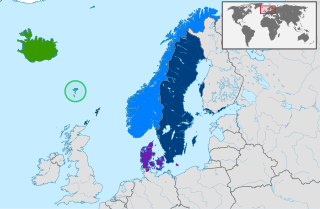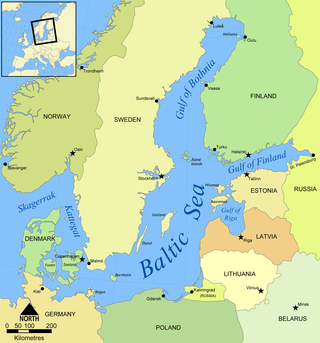
Scandinavia is a subregion in Northern Europe, with strong historical, cultural, and linguistic ties between its constituent peoples. Scandinavia most commonly refers to Denmark, Norway, and Sweden. In English usage, it can sometimes also refer more narrowly to the Scandinavian Peninsula, or more broadly to all of the Nordic countries, also including Finland, Iceland, and the Faroe Islands.

The North Germanic languages make up one of the three branches of the Germanic languages—a sub-family of the Indo-European languages—along with the West Germanic languages and the extinct East Germanic languages. The language group is also referred to as the Nordic languages, a direct translation of the most common term used among Danish, Faroese, Icelandic, Norwegian, and Swedish scholars and people.

The terms Baltic Sea Region, Baltic Rim countries, and the Baltic Sea countries/states refer to slightly different combinations of countries in the general area surrounding the Baltic Sea, mainly in Northern Europe. The term "Baltic states" refers specifically to one such grouping.

Scanian is an East Scandinavian dialect spoken in the province of Scania in southern Sweden. Present-day speakers of "Scanian" speak the Scanian dialect of Swedish. Older Scanian formed part of the old Scandinavian dialect continuum and are by most historical linguists considered to be an East Danish dialect group, but due to the modern-era influence from Standard Swedish in the region and because traditional dialectology in the Scandinavian countries normally has not considered isoglosses that cut across state borders, the Scanian dialects have normally been treated as a South Swedish dialect group in Swedish dialect research. However, many of the early Scandinavian linguists, including Adolf Noreen and G. Sjöstedt, classified it as "South Scandinavian", and some linguists, such as Elias Wessén, also considered Old Scanian a separate language, classified apart from both Old Danish and Old Swedish.

Danish overseas colonies and Dano-Norwegian colonies were the colonies that Denmark–Norway possessed from 1536 until 1953. At its apex, the colonies spanned four continents: Africa, Asia, Europe, and North America.

Swedish Americans are Americans of Swedish ancestry. They include the 1.2 million Swedish immigrants during 1865–1915, who formed tight-knit communities, as well as their descendants and more recent immigrants.
Nordic and Scandinavian Americans are Americans of Scandinavian and/or Nordic ancestry, including Danish Americans, Faroese Americans, Finnish Americans, Greenlandic Americans, Icelandic Americans, Norwegian Americans, and Swedish Americans. Also included are persons who reported 'Scandinavian' ancestry on their census. According to 2021 census estimates, there are approximately 9,365,489 people of Scandinavian ancestry in the United States.
The American-Scandinavian Foundation (ASF) is an American non-profit foundation dedicated to promoting international understanding through educational and cultural exchange between the United States and Denmark, Finland, Iceland, Norway, and Sweden. The Foundation's headquarters, Scandinavia House: The Nordic Center in America, is located at 58 Park Avenue, New York City.
Hani Miletski is a sexologist, and sex therapist living in Bethesda, Maryland. She specializes as a trainer and supervisor in the field, in sex addiction, and also works within the criminal justice system. She studied at The Catholic University of America and has a doctorate from the unaccredited Institute for Advanced Study of Human Sexuality.
Carl O. Nordling was a Finnish born architect, urban planner and amateur historian. He graduated as an architect from the Helsinki University of Technology in 1939 and immigrated to Sweden after the end of the Continuation War in 1944. Nordling published an article on the Holocaust, How Many Jews Died in the German Concentration Camps?, in the Holocaust denial publication Journal of Historical Review.

The Nordic model comprises the economic and social policies as well as typical cultural practices common to the Nordic countries. This includes a comprehensive welfare state and multi-level collective bargaining based on the economic foundations of social corporatism, and a commitment to private ownership within a market-based mixed economy — with Norway being a partial exception due to a large number of state-owned enterprises and state ownership in publicly listed firms.
Fornvännen, Journal of Swedish Antiquarian Research is a Swedish academic journal in the fields of archaeology and Medieval art. It is published quarterly by the Royal Swedish Academy of Letters, History and Antiquities in Stockholm, Sweden. The journal's contributions are written in the Scandinavian languages, English, or German with summaries in English. The editor-in-chief is Mats Roslund. The editorial board practices double blind peer review with external reviewers.
hprints is an archive for electronic preprints of academic papers in the fields of arts and humanities. It can be accessed freely via the Internet since it is an open access repository aiming at making scholarly documents publicly available to the widest possible audience.
The Nordic Journal of Human Rights is a peer-reviewed academic journal published by the Norwegian Centre for Human Rights in collaboration with Universitetsforlaget. The journal takes a broad and cross-disciplinary view on human rights, particularly in a Nordic context.
Retfærd, subtitled Nordic Journal of Law and Justice, is a Nordic peer-reviewed academic journal of legal science, publishing research from a "theoretical and practical point of view on the basis of not only jurisprudence, but also sociology, criminology, political science, history, philosophy, economics, ecology, anthropology, feminism and other sciences." Principally oriented towards Scandinavia, it primarily publishes articles in the Scandinavian languages, but also publishes special issues in English with a broader international focus. The journal was established in 1976 and since 2002 is published by the Association of Danish Lawyers and Economists. It was formerly published by Universitetsforlaget/the Scandinavian University Press. The journal is ranked as a Level 2 journal, the highest level, in the official Norwegian ranking.
The Scandinavian Journal of Psychology is a peer-reviewed academic journal on psychology. It is published in association with the Nordic Psychological Association and on behalf of the Scandinavian Psychological Associations. It was first published in 1960. The journal is divided into four sections: Cognition and Neurosciences, Development and Ageing, Personality and Social Psychology and Health and Disability.
Scandinavian Political Studies is a quarterly peer-reviewed academic journal covering political science in the Nordic countries published by Wiley-Blackwell. The current joint editors-in-chief are Åse Gornitzka and Carl Henrik Knutsen.

Skandinavskii sbornik, also Скандинавский сборник, Skandinaavia kogumik, and Skrifter om Skandinavien, was an annual serial publication of the history and wider humanities in Scandinavia and the Baltic. It was published by the University of Tartu in Estonia between 1956 and 1990 and has been described as the principal forum for scholars of Nordic studies in the Soviet region. It emphasised long-term trends over short-term events and had a philosophy that peaceful coexistence between nations and peoples was the most natural order of things. It ceased publication following the collapse of the Soviet Union.
Lambda Nordica is a peer-reviewed, open-access academic journal of LGBTQ studies. The journal is oldest of its kind in the Nordic region, dedicated to interdisciplinary research in lesbian/gay/bi/trans* and queer studies. It aims to foster international collaboration and dialogue, and to offer junior as well as senior researchers an opportunity to publish in both English and the Scandinavian languages. The journal also reviews Nordic and international literature in the field of LGBTQ studies.
Dieđut is a peer-reviewed academic journal published by the Nordic Sámi Institute. It features articles on social sciences, linguistics, and law. It was originally established to publish research findings from the Nordic Sámi Institute, but since 2005 has been affiliated with the Sámi University of Applied Sciences.







